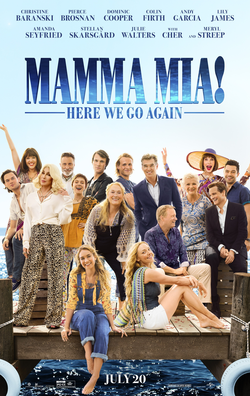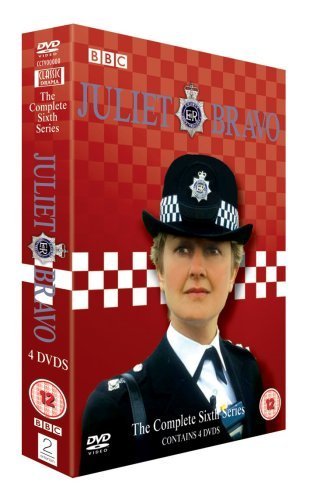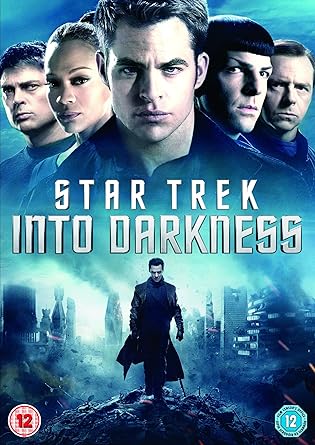A Review of Mama Mia: Here we go again
Carla "Campbell" (Gina Lollobrigida) is an Italian woman who - during the American occupation of Italy - slept with three American GIs in the course of 10 days, Cpl. Phil Newman (Phil Silvers), Lt. Justin Young (Peter Lawford), and Sgt. Walter Braddock (Telly Savalas). By the time she discovers she is pregnant, all three have moved on, and she, uncertain of which is the father, convinces each of the three (who are unaware of the existence of the other two) to support "his" daughter Gia financially.
And of course now the three men are coming back for a reunion... and which one is the father?
That’s the plot of the movie “Buona Sera, Mrs. Campbell” (1968). If that may seem familiar, it is because it was virtually the same plot as “Mamma Mia!” - a single mother trying to hide three potential fathers from the daughter she’s raised alone, honestly unaware of which man is the real parent. It was a shameless steal.
Some elements are different. It was not in the war, but in her student days after graduation that Donna meets the three men, but elements of the plot are the same. And it does work very well.
The reuniting of the girls from the Dynamos bandmates, wisecracking author Rosie Mulligan and wealthy multiple divorcée Tanya Chesham-Leigh, and the arrival of the three possible fathers, and the daughter’s own romance are all done very well leading to a lovely wedding sequence at a chapel at the top of a Greek island.
So what about “Mamma Mia! Here We Go Again”, the sequel? Unlike many sequels it does not suffer from trying to do the same kind of plot again. Instead of an old plot revamped, we actually have something new.
In this case, there is little of two of the fathers (Stellan Skarsgård, Colin Firth), and Pierce Brosnan doesn’t sing that much (which is a relief!) – although he does supply some rather tender fatherly love - and virtually just a cameo from Meryl Streep, along with another cameo from Cher.
But this is a story with perhaps even more heart to it than the first. I don’t think it gives much away that is not apparent in the opening five minutes to say that, in the present, Meryl Streep’s Donna has died – we don’t know how. And the current day of the movie is to do with her daughter re-opening the hotel her mother founded, as a tribute and memorial to her, and coming to terms with her grief. Indeed, the present is both about looking to future hope, and coping with past grief.
But alongside the present grief, is the past joy, as we are taken on the journey of the young Donna, graduating from Oxford, setting off to find herself (and in three men’s beds on the way) before ending up on the Greek island we know and love so well from the first film, and the backdrop from the present.
This intercutting of past and present provides the emotional core of the film and I have to say it ends with a real tear-jerker as we see Donna in the church for the baptism of her own daughter, alone apart from the supportive Island community (and she has only one friendly inn-keeper woman at the birth earlier), and her daughter’s own child’s baptism. I won’t give away too many more spoilers except to say it is a moment to keep the tissues to hand.
But along the journey, there is a lot of wild and lively spirits, some really good musical dance numbers to Abba songs, and a great deal of humour – including some rather rude but wickedly funny lines! There was laughter in the cinema, and not just from me! (It’s always worrying when I am the only one laughing at a film, as I did during the more ridiculous parts of “The Exorcist”)
Lily James as Young Donna just shines as we follow her journey, but she is matched well in the present by Amanda Seyfried as Sophie Sheridan, Donna’s 25-year-old daughter.
There’s a lot of fun in seeing the younger counterparts to Donna and the Dynamos, and the actors playing the younger parts of the three “fathers”. Hugh Skinner, as the young Colin Firth may be the most familiar face as interne Will from W1A, the spoof about the BBC, but all three acquit themselves very well (and it has to be said are better singers than their elder counterparts).
The ABBA team themselves have cameos, Björn Ulvaeus as an Oxford professor and Benny Andersson as "Waterloo" piano player.
Julie Walters provides some wonderful physical comedy with her dancing sequences, while there’s a rather nice and amusing cameo from Celia Imre at the Oxford sequence.
But even the smaller parts are memorable. Maria Vacratsis as Sofia, a local who owns the bar and shack which eventually becomes Donna's home is a wonderful part. She is supportive of Donna because Donna has “a heart” and took care of her horse in a storm, and Sophia delivers Sophie.
And of course there are the wonderful ABBA songs, mostly well known ones – although there are some lesser known ones - "Kisses of Fire", "Andante, Andante” and “The Day Before You Came". These are still lovely songs, and it is perhaps good to be reminded that while not everything ABBA wrote and performed became a hit, there is still some very good material there.
It ends with a show stopping all cast present, all dressed up in suitably ABBA style wear, of Super Trouper, a fun show stopping finale... or is it? Wait until the end credits roll, and you’ll be treated to just a small but very funny vignette.
This is a film which comes after the 2008 movie – ten years in the making – and goodness how grizzled and elderly Pierce Brosnan is, and even Colin Firth is showing his age. Mind you, I look a lot older two, and like the Swedish character Bill Anderson, have lost rather a lot of hair on top over the decade!
Would I recommend it? Definitely – and I would also say that alongside the froth of some of the fun big musical numbers, there’s also an emotional heart which is actually stronger than the original.
Carla "Campbell" (Gina Lollobrigida) is an Italian woman who - during the American occupation of Italy - slept with three American GIs in the course of 10 days, Cpl. Phil Newman (Phil Silvers), Lt. Justin Young (Peter Lawford), and Sgt. Walter Braddock (Telly Savalas). By the time she discovers she is pregnant, all three have moved on, and she, uncertain of which is the father, convinces each of the three (who are unaware of the existence of the other two) to support "his" daughter Gia financially.
And of course now the three men are coming back for a reunion... and which one is the father?
That’s the plot of the movie “Buona Sera, Mrs. Campbell” (1968). If that may seem familiar, it is because it was virtually the same plot as “Mamma Mia!” - a single mother trying to hide three potential fathers from the daughter she’s raised alone, honestly unaware of which man is the real parent. It was a shameless steal.
Some elements are different. It was not in the war, but in her student days after graduation that Donna meets the three men, but elements of the plot are the same. And it does work very well.
The reuniting of the girls from the Dynamos bandmates, wisecracking author Rosie Mulligan and wealthy multiple divorcée Tanya Chesham-Leigh, and the arrival of the three possible fathers, and the daughter’s own romance are all done very well leading to a lovely wedding sequence at a chapel at the top of a Greek island.
So what about “Mamma Mia! Here We Go Again”, the sequel? Unlike many sequels it does not suffer from trying to do the same kind of plot again. Instead of an old plot revamped, we actually have something new.
In this case, there is little of two of the fathers (Stellan Skarsgård, Colin Firth), and Pierce Brosnan doesn’t sing that much (which is a relief!) – although he does supply some rather tender fatherly love - and virtually just a cameo from Meryl Streep, along with another cameo from Cher.
But this is a story with perhaps even more heart to it than the first. I don’t think it gives much away that is not apparent in the opening five minutes to say that, in the present, Meryl Streep’s Donna has died – we don’t know how. And the current day of the movie is to do with her daughter re-opening the hotel her mother founded, as a tribute and memorial to her, and coming to terms with her grief. Indeed, the present is both about looking to future hope, and coping with past grief.
But alongside the present grief, is the past joy, as we are taken on the journey of the young Donna, graduating from Oxford, setting off to find herself (and in three men’s beds on the way) before ending up on the Greek island we know and love so well from the first film, and the backdrop from the present.
This intercutting of past and present provides the emotional core of the film and I have to say it ends with a real tear-jerker as we see Donna in the church for the baptism of her own daughter, alone apart from the supportive Island community (and she has only one friendly inn-keeper woman at the birth earlier), and her daughter’s own child’s baptism. I won’t give away too many more spoilers except to say it is a moment to keep the tissues to hand.
But along the journey, there is a lot of wild and lively spirits, some really good musical dance numbers to Abba songs, and a great deal of humour – including some rather rude but wickedly funny lines! There was laughter in the cinema, and not just from me! (It’s always worrying when I am the only one laughing at a film, as I did during the more ridiculous parts of “The Exorcist”)
Lily James as Young Donna just shines as we follow her journey, but she is matched well in the present by Amanda Seyfried as Sophie Sheridan, Donna’s 25-year-old daughter.
There’s a lot of fun in seeing the younger counterparts to Donna and the Dynamos, and the actors playing the younger parts of the three “fathers”. Hugh Skinner, as the young Colin Firth may be the most familiar face as interne Will from W1A, the spoof about the BBC, but all three acquit themselves very well (and it has to be said are better singers than their elder counterparts).
The ABBA team themselves have cameos, Björn Ulvaeus as an Oxford professor and Benny Andersson as "Waterloo" piano player.
Julie Walters provides some wonderful physical comedy with her dancing sequences, while there’s a rather nice and amusing cameo from Celia Imre at the Oxford sequence.
But even the smaller parts are memorable. Maria Vacratsis as Sofia, a local who owns the bar and shack which eventually becomes Donna's home is a wonderful part. She is supportive of Donna because Donna has “a heart” and took care of her horse in a storm, and Sophia delivers Sophie.
And of course there are the wonderful ABBA songs, mostly well known ones – although there are some lesser known ones - "Kisses of Fire", "Andante, Andante” and “The Day Before You Came". These are still lovely songs, and it is perhaps good to be reminded that while not everything ABBA wrote and performed became a hit, there is still some very good material there.
It ends with a show stopping all cast present, all dressed up in suitably ABBA style wear, of Super Trouper, a fun show stopping finale... or is it? Wait until the end credits roll, and you’ll be treated to just a small but very funny vignette.
This is a film which comes after the 2008 movie – ten years in the making – and goodness how grizzled and elderly Pierce Brosnan is, and even Colin Firth is showing his age. Mind you, I look a lot older two, and like the Swedish character Bill Anderson, have lost rather a lot of hair on top over the decade!
Would I recommend it? Definitely – and I would also say that alongside the froth of some of the fun big musical numbers, there’s also an emotional heart which is actually stronger than the original.





















/arc-anglerfish-arc2-prod-jerseyeveningpost-mna.s3.amazonaws.com/public/3KWHAVKWB5AKNAFGDJWN6VPM64.jpg)







































